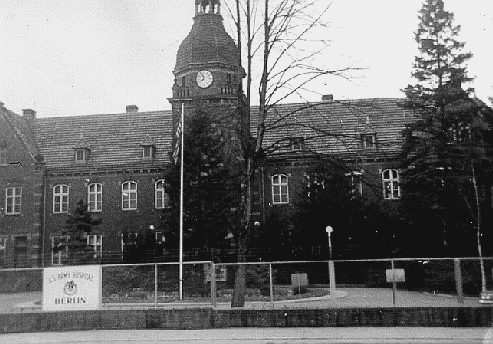Andrews, McNair Located in Steglitz
|
|
The borough of Steglitz, first settled more than 700 years ago by a small group of farmers, today comprises the former rural parishes of Steglitz proper, Gross Lichterfelde, Lankwitz and Sudende. Although the 30 Years War leveled all that was productive in Steglitz and left the area a veritable graveyard, toward the turn of the 18th century Steglitz began to be rebuilt. The population soared during the next 200 years from 150 to 50,000. Today 200,000 people live within the 7,892 acres of the borough.
A large percentage of the Americans in Berlin serve in Steglitz. It is the home of McNair and Andrews Barracks, the U. S. Army Hospital, the Quartermaster Depot and the Engineer Compound. Historically, Andrews Barracks was part of the original compound built in 1873 by Kaiser Wilhelm I to house his cadet troops; it was then called the Lichterfelder Kaserne.
|

|
|
The Andrews Barracks Pool, located just inside the main gate of the compound, was built during the hey-day of the National Socialists for the 1936 Olympics. The pool, building, and facilities therein, including a bowling alley, are valued at over $400,000.
The indoor pool is one of the most complete of its type in the world, with a capacity of approximately 1,200,OOO gallons of water. The pool is 50 meters long, 25 meters wide and ranges in depth from 15 feet at the deepest to eight feet at the shallow end .
Balconies surround the pool, affording an excellent view.
McNair Barracks is dedicated to the memory of Lieutenant General Lesley J. McNair, commander of U. S. ground forces, killed in action at Normandy on July 17, 1944. It is the home of the three infantry battalions and attached units in Berlin. Prior to the end of World War II the buildings were all part of the Telefunken research laboratories. The buildings are still owned by the Telefunken Company and are leased by it to the U. S. Army.
|

|
|
The U. S. Army Hospital is organized as the 279th Station Hospital and has occupied the hospital compound on Unter den Eichen since September 1945. The hospital was built around the turn of the century as a private institution and was taken over by the German government in 1941 for the care of Waffen-SS troops until the end of the war. The Red Army occupied it for a short time but since late 1945 it has been used by U. S. personnel.
A walk along the Schloss Strasse in Steglitz, noted among West Berliners as one of the best shopping streets, will provide an interesting sojourn. The street developed into one of Berlin's main shopping areas as a result of the war, largely taking the place of the severely damaged Leipziger Strasse in East Berlin. Beginning at the Rathaus Steglitz, built in 1896 in the brick gothic style characteristic of the Mark of Brandenburg, one progresses down the street to a house number 13 bearing a plaque in memory of the existentialist Franz Kafka who lived there in 1922-23. Where the Schloss Strasse widens, traces of the old village green become discernible. Here stands a life size bronze memorial erected in 1960 to those persecuted in 1933-45.
Next comes the Schlosshotel which was originally a manor house built by Heinrich Gentz in 1804 for Cabinet Councillor Beyme. The manor house later gained fame in the
middle of the 19th century as the residence of Field Marshal Wrangel, commander of Prussian troops during the revolution of 1848. Acting on order from King Frederick Wilhelm IV, Wrangel quelled the civil uprising in Berlin by leading his soldiers
from Potsdam through the heart of Berlin to the Brandenburg Gate.
|
|

